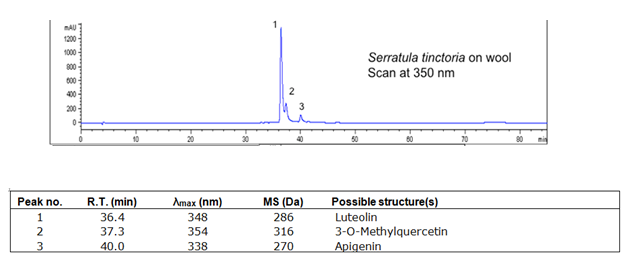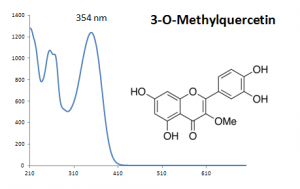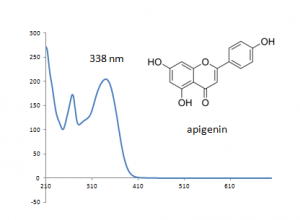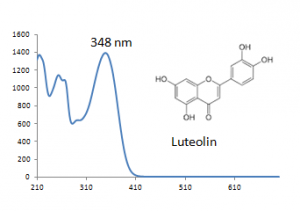Difference between revisions of "Sawwort (Serratula tinctoria) LC"
| (10 intermediate revisions by 2 users not shown) | |||
| Line 1: | Line 1: | ||
| − | [[File:|thumb|''' | + | [[File:Asteraceae - Serratula tinctoria-1.jpg|thumb|''Serratula tinctoria'' flower Photo by Hectonichus - Own work, CC BY-SA 3.0, https://commons.wikimedia.org/w/index.php?curid=15574321]] |
== Description == | == Description == | ||
| + | ''Serratula tinctoria'' is commonly known as dyer's plumeless saw-wort or saw-wort. It is a native of Europe and a thistle like flower head. It grows in moist soil, full sun to part shade, and grows up to one meter tall. | ||
== Historical importance == | == Historical importance == | ||
| + | Saw-wort is a well-known dye plant in Europe and the flowers give a lemon-yellow color. | ||
| − | = Summary of results = | + | == Summary of results == |
| + | Flavonoids were identified from the whole plant (aerial part) dyed wool from Turkey. | ||
| + | == Analytical instrumentation and procedures == | ||
| − | + | HPLC-DAD-MS analysis was performed with an Agilent 1100 liquid chromatography system consisting of an automatic injector, a gradient pump, a HP series 1100 DAD, and an Agilent series 1100 VL on-line atmospheric pressure ionization electrospray ionization mass spectrometer. Separations were done on a Vydac 214TP52 analytical column (2.1 mm diameterX250 mm; 5-ím particle size). The column was eluted at a flow rate of 0.2 mL/min with a tertiary gradient of water (A),acetonitrile (B), and 1% (v/v) aqueous formic acid (C) with the following elution program: 0 min, 90% A, 5% B, 5% C; 0-55 min, a linear gradient to 35% A, 60% B, 5% C; 55-60 min, a linear gradient elution to 15% A, 80% B, 5% C; 60-62 min, isocratic elution at 15% A, 80% B, 5% C; 62-70 min gradient elution to 90% A, 5% B, 5% C; and reequilibration with the latter solvent for 15 min. The mass spectrometer was run both in the negative and positive ion mode. | |
| − | + | == Chromatograms == | |
| − | = Chromatograms = | ||
| Line 21: | Line 24: | ||
| − | Sample information | + | == Sample information == |
[[File:Sawwort info.PNG|center|frame|sample information, By R. A. Laursen, Boston University ]] | [[File:Sawwort info.PNG|center|frame|sample information, By R. A. Laursen, Boston University ]] | ||
| − | = Identified compounds = | + | == Identified compounds == |
| − | [[[SliderGallery rightalign|~HPLC-DAD|. | + | [[[SliderGallery rightalign|~HPLC-DAD|3-o-methylquercetin.PNG~ UV-Vis 3-O-Methylquercetin|Apigenin.PNG~ Apigenin UV-Vis|Luteolin.PNG~ Luteolin UV-Vis]]] |
{| class="wikitable" | {| class="wikitable" | ||
| Line 45: | Line 48: | ||
| 3-O-Methylquercetin | | 3-O-Methylquercetin | ||
| 37.3 | | 37.3 | ||
| + | | 316 | ||
| 354 | | 354 | ||
| − | |||
| | | | ||
|- | |- | ||
| Apigenin | | Apigenin | ||
| 40.0 | | 40.0 | ||
| − | | | + | | 270 |
| − | | | + | | 338 |
| | | | ||
|} | |} | ||
| Line 63: | Line 66: | ||
| − | [[Category:Analysis | + | [[Category:Dye Analysis]] |
| + | [[Category:Reference Materials]] | ||
| + | [[Category:Natural Dyes]] | ||
Latest revision as of 09:22, 29 September 2017
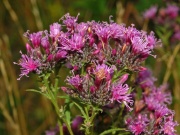
Description
Serratula tinctoria is commonly known as dyer's plumeless saw-wort or saw-wort. It is a native of Europe and a thistle like flower head. It grows in moist soil, full sun to part shade, and grows up to one meter tall.
Historical importance
Saw-wort is a well-known dye plant in Europe and the flowers give a lemon-yellow color.
Summary of results
Flavonoids were identified from the whole plant (aerial part) dyed wool from Turkey.
Analytical instrumentation and procedures
HPLC-DAD-MS analysis was performed with an Agilent 1100 liquid chromatography system consisting of an automatic injector, a gradient pump, a HP series 1100 DAD, and an Agilent series 1100 VL on-line atmospheric pressure ionization electrospray ionization mass spectrometer. Separations were done on a Vydac 214TP52 analytical column (2.1 mm diameterX250 mm; 5-ím particle size). The column was eluted at a flow rate of 0.2 mL/min with a tertiary gradient of water (A),acetonitrile (B), and 1% (v/v) aqueous formic acid (C) with the following elution program: 0 min, 90% A, 5% B, 5% C; 0-55 min, a linear gradient to 35% A, 60% B, 5% C; 55-60 min, a linear gradient elution to 15% A, 80% B, 5% C; 60-62 min, isocratic elution at 15% A, 80% B, 5% C; 62-70 min gradient elution to 90% A, 5% B, 5% C; and reequilibration with the latter solvent for 15 min. The mass spectrometer was run both in the negative and positive ion mode.
Chromatograms
Sample information
Identified compounds
| Compound | RT (min.) | MW | UV/vis | Other |
|---|---|---|---|---|
| Luteolin | 36.4 | 286 | 348 | Comments here |
| 3-O-Methylquercetin | 37.3 | 316 | 354 | |
| Apigenin | 40.0 | 270 | 338 |
References
[1] [2] [3]
